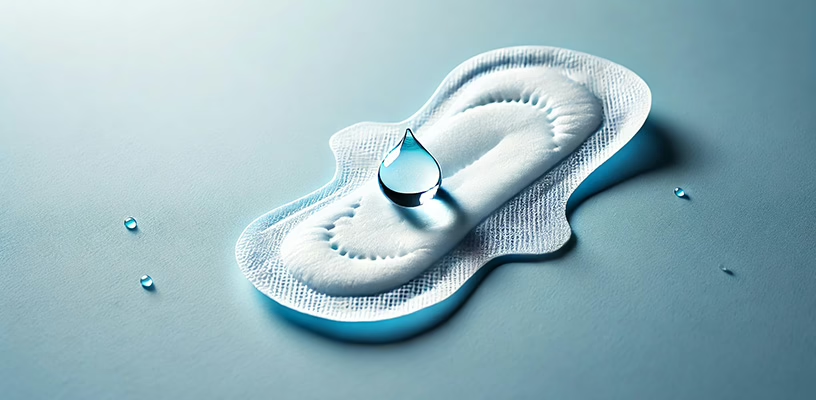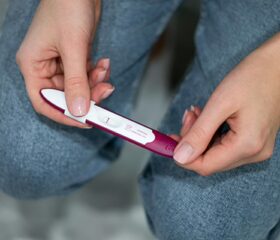Is Watery Discharge During Early Pregnancy Normal?
Producing vaginal discharge is a normal part of being pregnant, and if it’s watery, that’s usually nothing to worry about.

It’s normal to have increased vaginal discharge when you’re pregnant. You might notice that it changes throughout your pregnancy—it’s very common for it to be thinner during early pregnancy and thicker when you’re near labor.
Keep reading to learn what normal discharge is like during different stages of pregnancy and when you should see a doctor.
What is vaginal discharge?
Women start producing vaginal discharge (also called leukorrhea) when they hit puberty. It consists mainly of water, mucus, and some microorganisms. You can think of it as your body’s natural cleanser, as it removes dead cells from your vagina to keep it clean and healthy. 1
It’s normal for the volume of your vaginal discharge to change throughout your regular menstrual cycle. Generally, normal discharge has the following characteristics:
- Color: Clear or milky-white.
- Texture: Thin or watery.
- Odor: Mild or no odor.
You may produce more discharge when you’re ovulating, sexually aroused, or pregnant. 2
Is watery discharge a sign of pregnancy?
Watery discharge isn’t a sure sign that you’re pregnant, although it can be an early pregnancy symptom.
While it’s common for discharge to increase in volume and become thinner during pregnancy, if you suspect you may have conceived, it’s best to take a pregnancy test to confirm.
You can buy at-home pregnancy tests at a local pharmacy or supermarket.
How your discharge will change in different stages of pregnancy
The nature of your discharge will vary at different stages of your pregnancy:
Early pregnancy
Again, in the early weeks, you might notice an increase in your vaginal discharge. This is mainly due to your body’s hormonal changes—specifically, due to your elevated levels of estrogen. 1 3
In addition to increased vaginal discharge, you may occasionally notice some spotting during your pregnancy (usually a few drops of blood on your underwear), or even vaginal bleeding. 4
You generally don’t need to worry about a little spotting in your first trimester, but you should still let your doctor know about it so that they can monitor your health.
Mid-pregnancy
As you move into the second trimester, you’ll continue to produce milky-white discharge.
The amount may vary from day to day, and it may become thinner as your pregnancy progresses. 5
Late pregnancy
In the final weeks of pregnancy, you may notice that your discharge is heavier and tinged with bloody mucus. This “bloody show,” which may show up as red-streaked or brown pregnancy discharge, appears when your mucus plug, which protects your uterus during pregnancy, dislodges so that you can give birth. 6
Losing your mucus plug suggests your body is preparing for labor. However, you may still be a few days or weeks away from entering active labor.
What’s the difference between watery discharge and amniotic fluid (your water breaking)?
Make sure you know the difference between normal discharge and amniotic fluid (the liquid that surrounds your baby). Amniotic fluid is a clear or slightly yellowish fluid that’s often watery and doesn’t smell like urine. 7
If you feel a gush or steady trickle of fluid leak from your vagina, that’s likely amniotic fluid and not your regular discharge.
When this happens, it means the amniotic sac that contains your baby has ruptured (i.e., your water has broken), which is one of the telltale signs of labor. Contact your doctor as soon as your amniotic sac ruptures.
Tips to manage watery discharge during pregnancy
While watery discharge during pregnancy is normal, some women find it a bit uncomfortable.
You can minimize any discomfort you experience with:
- Basic hygiene: Though you may have a harder time taking a shower when you’re pregnant (especially in the later stages), a shower or bath every day will keep you clean and comfortable. You can avoid irritating your skin by using gentle, unscented cleansers.
- Breathable underwear: Choose cotton underwear, as it’s more breathable than synthetic fabric.
- Panty liners: You can also wear panty liners, which will help absorb your increased discharge. Choose breathable cotton liners to minimize irritation.
- Frequent liner or underwear changes: Change your liners and underwear regularly to keep things as fresh as possible.
Avoid douching, whether you’re pregnant or not
Douching—washing your vagina with water or other liquid—is fairly common, but medical professionals recommend against it. It can lead to pregnancy issues, vaginal infection, and even STIs. Doctors suggest you should avoid douching even if you aren’t pregnant. 8
When should you be concerned about watery discharge?
As you know, water discharge is normal during pregnancy. That said, certain changes could mean that something’s wrong.
Call your doctor if you experience any of the following: 9
- Changes in color: You might have an infection (e.g., bacterial vaginosis) if your pregnancy discharge is yellow, green, or gray. 10
- Changes in consistency: Discharge that’s particularly thick and whitish indicates a possible yeast infection, which you’re more likely to have during pregnancy. 3
- Excessive discharge: A sudden and excessive amount of discharge, especially if it’s not the normal watery type, warrants medical attention.
- Foul odor: A strong, unpleasant odor is another sign of a possible infection.
- Heavy bleeding: You should notify your doctor immediately if you have any significant bleeding or discharge that’s brown, pinkish, or tinged with red streaks of blood.
- Other symptoms: Discharge accompanied by itching, burning, soreness, pelvic pain, fever, or pain during sex should be checked by your doctor.
Final thoughts
There’s no need to worry if you have watery discharge during early pregnancy (or later). Although it may sometimes feel a bit uncomfortable, it’s a sign that your body is busy keeping you and your baby healthy.
Keep an eye out for sudden changes in your discharge, and when in doubt, call your doctor for peace of mind. Otherwise, trust that your body knows what it’s doing.
Article Sources
- American College of Obstetricians and Gynecologists. "Vulvovaginal Health" Retrieved August 22, 2025.
- MedlinePlus. "Vaginal itching and discharge - adult and adolescent" Retrieved August 22, 2025.
- University of Rochester Medical Center. "Common Discomforts During Pregnancy" Retrieved August 22, 2025.
- MedlinePlus. "Vaginal bleeding in early pregnancy" Retrieved August 22, 2025.
- Stony Brook Medicine. "My Discharge - Is it normal?" Retrieved August 22, 2025.
- MedlinePlus. "Am I in labor?" Retrieved August 22, 2025.
- MedlinePlus. "Amniotic fluid" Retrieved August 22, 2025.
- Office on Women's Health. "Douching" Retrieved August 22, 2025.
- MedlinePlus. "Common symptoms during pregnancy" Retrieved August 22, 2025.
- Cleveland Clinic. "Bacterial Vaginosis" Retrieved August 22, 2025.







